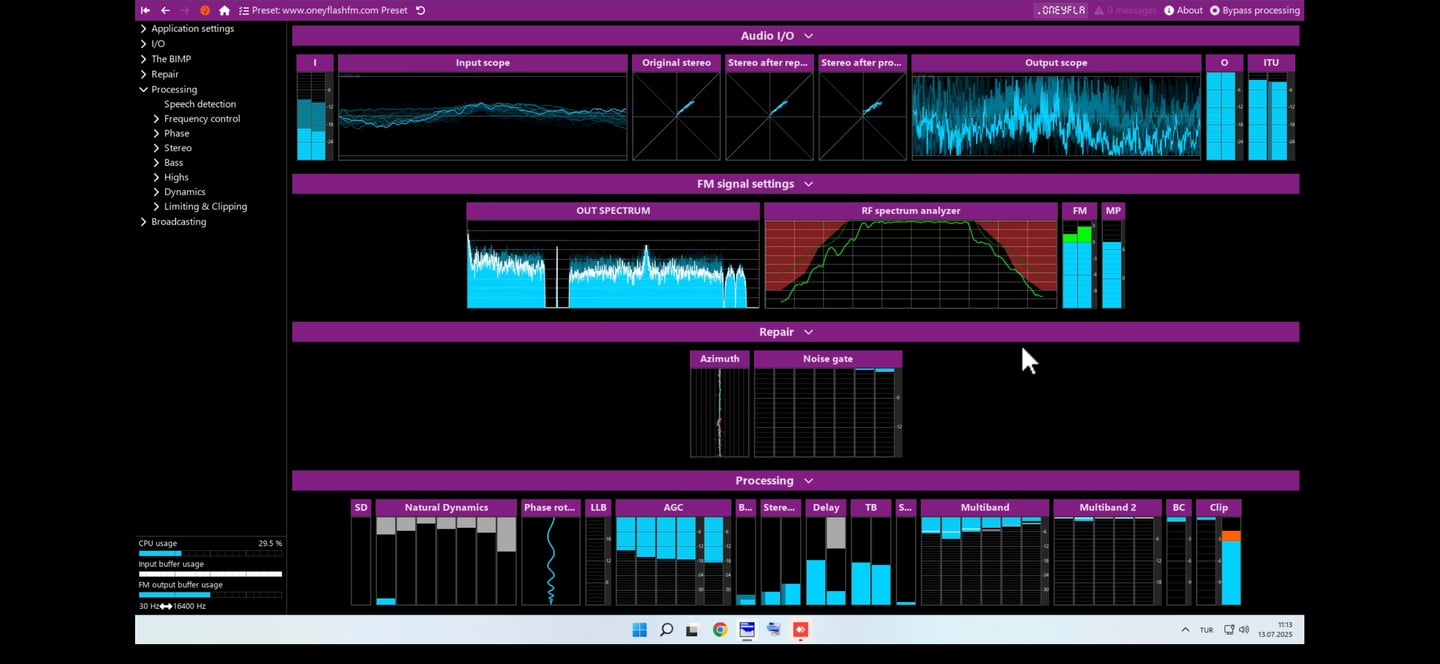🎶 Stereo Tool: Audio Processor and Its Features
✍️ Written by: TB7AEK Ayberk Efe Korkmaz
AYBERK BLOG
🎶 Stereo Tool: Audio Processor and Its Features
✍️ Written by: TB7AEK Ayberk Efe Korkmaz
🎧 What is Stereo Tool?
Stereo Tool is a powerful audio processor and signal processing software primarily used by radio broadcasters and audio engineers. This software is capable of performing a wide variety of tasks, optimizing sound quality, and ensuring consistent audio levels for FM or internet radio broadcasts.
Stereo Tool works by digitally processing audio signals, improving the sound quality, and helping radio stations achieve a professional audio experience. With its advanced audio algorithms, the software helps shape the sound to meet specific broadcast requirements.
🛠️ Features of Stereo Tool
1️⃣ Dynamic Range Expansion
Stereo Tool uses dynamic compression to balance audio levels. It expands the dynamic range by increasing low sounds and reducing high ones. This feature ensures that radio broadcasts have consistent and dynamic audio that is comfortable for listeners.
2️⃣ Advanced Equalizer (EQ) Features
Stereo Tool offers a precise equalizer to adjust high and low frequencies. The equalizer works by correcting frequency imbalances, resulting in a natural, clear, and powerful sound.
Bands: Options for 3, 5, 10, or 30-band equalizer settings to fine-tune the audio across various frequency ranges.
3️⃣ Stereo to Mono Conversion
Stereo Tool can process audio signals in mono or stereo mode. This feature is essential for stations that may have mono compatibility issues. If stereo needs to be converted into mono, the stereo-to-mono conversion ensures minimal signal loss.
4️⃣ Limiting and Compression
Stereo Tool provides limiting features to control the peak levels of audio signals. Limiting prevents distortion and allows radio stations to achieve higher audio levels without damaging the signal. Additionally, compression algorithms help maintain a consistent audio level.
Peak Limiter: Prevents distortion and clipping.
Multiband Compressor: Compresses different frequency bands to achieve a smooth overall sound.
5️⃣ RDS and SCA Support
Stereo Tool also supports RDS (Radio Data System) and SCA (Subsidiary Communications Authorization), which are essential for transmitting additional data, such as frequency information or song titles, alongside the audio. This integration enhances the broadcast by adding professional features.
6️⃣ Advanced Modulation Control
Stereo Tool offers control over FM modulation. This feature is critical for FM broadcasting stations as modulation directly impacts the quality of the transmitted sound. Stereo Tool ensures that the modulation remains stable and high quality, preventing distortion.
💻 How to Use Stereo Tool
Stereo Tool works on both Windows and Linux platforms, providing real-time audio processing. The software is hardware-independent, meaning it does not require specialized equipment or sound cards to function.
The user interface is designed to be intuitive, making it easy to use for both professional and amateur broadcasters. Additionally, Stereo Tool can be used as a VST plugin, allowing seamless integration with Digital Audio Workstations (DAWs).
🎚️ Key Controls and Settings:
Input Gain: Adjust the signal level at the input stage.
Output Gain: Control the signal level at the output stage.
Stereo Width: Adjust the stereo width and dynamic features.
Saturation: Enhance the warmth of the signal.
Preset Settings: Quickly switch between different sound profiles for various broadcasting needs.
🎵 Benefits of Stereo Tool
Improved Sound Quality: Stereo Tool delivers high-quality, consistent sound for broadcasts, ensuring a professional listening experience.
Higher Audio Levels: Thanks to limiting and compression, you can achieve higher audio levels without compromising quality.
Advanced Modulation: For FM broadcasts, it ensures the modulation remains stable and of high quality.
Easy Integration: Works both as a VST plugin and as standalone software, offering flexibility for broadcasters.
🔧 Applications of Stereo Tool
FM Radio Broadcasting: Stereo Tool ensures that the sound transmitted via FM radio is of high quality and optimized.
Internet Radio: It helps online radio stations achieve optimal audio levels and sound quality.
Music Production: Used in music production for digital signal processing and optimization.
Podcasting and Voice Over: Ideal for podcasters and voice-over artists who need professional audio processing.
📊 Stereo Tool Audio Processing Workflow
The basic audio processing workflow in Stereo Tool includes the following steps:
Audio Input: Stereo Tool receives the audio signal from the input source (microphone, sound card, radio transmitter, etc.).
Signal Processing: The signal goes through various compression, limiting, equalization, and modulation processes.
Output Signal: The processed signal is then transmitted to the FM transmitter, streaming platforms, or other audio devices.
🧑🔧 Conclusion
Stereo Tool is an excellent tool for audio engineering and radio broadcasting. It uses professional-grade audio processing techniques to help broadcasters achieve clear, dynamic, and consistent sound quality. With its advanced compression, limiting, modulation, and equalizer features, Stereo Tool helps you produce professional-grade broadcasts that sound polished and reliable.
If you are a radio broadcaster or an audio content creator, Stereo Tool is definitely worth considering for enhancing your sound quality and making your broadcasts more professional. 🎧🎶
✍️ Prepared by:
TB7AEK Ayberk Efe Korkmaz

